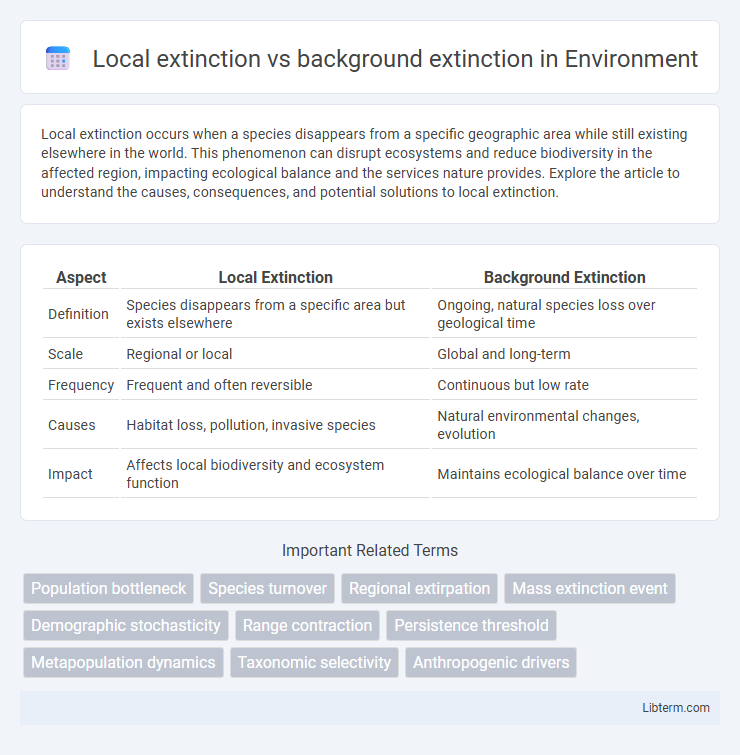Local extinction occurs when a species disappears from a specific geographic area while still existing elsewhere in the world. This phenomenon can disrupt ecosystems and reduce biodiversity in the affected region, impacting ecological balance and the services nature provides. Explore the article to understand the causes, consequences, and potential solutions to local extinction.
Table of Comparison
| Aspect | Local Extinction | Background Extinction |
|---|---|---|
| Definition | Species disappears from a specific area but exists elsewhere | Ongoing, natural species loss over geological time |
| Scale | Regional or local | Global and long-term |
| Frequency | Frequent and often reversible | Continuous but low rate |
| Causes | Habitat loss, pollution, invasive species | Natural environmental changes, evolution |
| Impact | Affects local biodiversity and ecosystem function | Maintains ecological balance over time |
Understanding Local Extinction: Definition and Examples
Local extinction refers to the disappearance of a species from a specific geographic area while it continues to exist elsewhere, contrasting with background extinction, which denotes the natural rate of species loss over time globally. Examples include the extirpation of wolves in certain U.S. states, despite their presence in other regions, and the loss of local amphibian populations due to habitat destruction. Understanding local extinction highlights the importance of regional conservation efforts to maintain biodiversity within particular ecosystems.
What is Background Extinction?
Background extinction refers to the normal, ongoing loss of species during periods when no mass extinction events occur, typically caused by environmental changes, habitat loss, and natural selection. It contrasts with local extinction, which involves the disappearance of a species from a specific geographic area without going globally extinct. Background extinction rates provide a baseline for understanding species turnover and ecosystem dynamics over geological time scales.
Key Differences Between Local and Background Extinction
Local extinction refers to the disappearance of a species from a specific geographic area while it continues to exist elsewhere, whereas background extinction is the routine, natural loss of species occurring over geological time scales. Key differences include the scale and frequency: local extinctions are more frequent and confined to regional habitats, whereas background extinctions happen globally at a slower rate due to evolutionary pressures and environmental changes. Understanding these distinctions aids in conservation strategies by targeting localized threats distinct from broader evolutionary processes.
Causes of Local Extinction Events
Local extinction occurs when a species disappears from a specific geographic area but exists elsewhere, often driven by habitat destruction, invasive species, pollution, and climate change impacting local ecosystems. Habitat fragmentation due to urbanization and deforestation disrupts breeding and foraging areas, while invasive species can outcompete or prey on native species, leading to their localized disappearance. Pollution, including chemical contaminants and nutrient runoff, degrades habitat quality, and climate shifts alter temperature and precipitation patterns, stressing species unable to adapt quickly.
Factors Driving Background Extinction Rates
Background extinction rates are influenced primarily by gradual environmental changes, including climate fluctuations, habitat alteration, and evolutionary pressures that gradually reduce species populations over geological timescales. Natural factors such as volcanic activity, sea-level changes, and competition among species also drive these extinction rates steadily rather than suddenly. Local extinction, by contrast, occurs within specific geographic areas but does not necessarily impact the species' survival globally, highlighting the difference in scale and impact compared to background extinction.
Ecological Impacts of Local Extinction
Local extinction, or extirpation, results in the disappearance of a species from a specific geographic area while it continues to exist elsewhere, contrasting with background extinction, which is the natural, gradual loss of species over time. The ecological impacts of local extinction include disruption of food webs, loss of ecosystem services such as pollination or seed dispersal, and altered habitat structures that reduce biodiversity and ecosystem resilience. These changes can lead to cascading effects, increasing vulnerability to invasive species and diminishing ecosystem stability.
Long-Term Consequences of Background Extinction
Background extinction refers to the natural, ongoing process of species loss occurring at a relatively low rate over geological time, contrasting with local extinction which involves species disappearing from specific areas but surviving elsewhere. The long-term consequences of background extinction include gradual shifts in biodiversity, influencing ecosystem stability and evolutionary pathways by allowing new species to emerge and fill ecological niches. This process maintains ecological balance, preventing monocultures and promoting resilience in global ecosystems.
Case Studies: Local vs Background Extinction in Wildlife
Case studies of local extinction often highlight species like the Tasmanian tiger in mainland Australia, where habitat loss and human activity led to regional disappearance despite global survival of related species. Background extinction, occurring at a slower, natural rate, involves gradual species loss exemplified by the decline of amphibian populations worldwide due to disease and environmental changes. Comparing these case studies reveals how local extinction impacts ecosystem dynamics and biodiversity differently than the steady, planet-wide processes of background extinction.
Conservation Strategies: Addressing Both Extinction Types
Conservation strategies must differentiate between local extinction, where species disappear from specific habitats, and background extinction, the gradual loss occurring at natural rates over time. Targeted habitat restoration and protected area networks address local extinction by preserving critical ecosystems and promoting species recolonization. To mitigate background extinction, conservation emphasizes maintaining genetic diversity and ecosystem resilience through sustainable management and global biodiversity policies.
The Importance of Monitoring Local and Background Extinctions
Monitoring local and background extinctions is crucial for understanding ecosystem health and biodiversity trends. Local extinctions indicate immediate habitat or species-level threats, allowing targeted conservation efforts before species decline globally. Background extinction rates provide a baseline for natural species loss, helping to identify abnormal spikes that signal environmental crises requiring urgent intervention.
Local extinction Infographic

 libterm.com
libterm.com